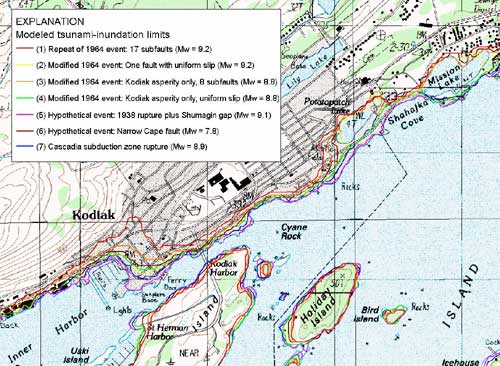
by Ned Rozell
January 21, 2005
On March 27, 1964, a magnitude 9.2 earthquake ripped through the sea floor in Prince William Sound and generated local and Pacific-wide tsunamis that killed 106 people in Alaska and others as far away as California. Though the death toll in 1964 is miniscule compared to the Indian Ocean disaster, quotes from Alaska survivors on a new video and DVD are similar to those from India, Sri Lanka, Thailand and Sumatra.  Image courtesy Elena Suleimani.
"Longshoremen and the visitors that were on the dock (were) running this way trying to get to the shore and (the dock) broke away," Gilson said. "Finally the dock busted up and they all disappeared, never to be seen again." Seward was another Alaska community devastated by tsunamis. On "Ocean Fury," residents describe how tsunamis in Resurrection Bay destroyed much of the town's waterfront. "Power had gone out. The sewers were gone. The water was gone. There was absolutely nothing left in the way of utilities," said Patricia Williams of Seward. "Basically, for us, Seward was gone," said Al Burch, "because our livelihood was gone, our employment was gone, the canneries were gone." Tsunamis caused by the 1964 Alaska earthquake also wrecked 158 houses and killed eight people in Kodiak, killed 23 people (one-third of the residents) in the village of Chenega in Prince William Sound, killed 12 in Whittier, and ripped across the Pacific to kill 11 people in Crescent City, California and four more in Newport, Oregon. Tsunamis are a great risk for coastal Alaska and on every piece of land that touches the Pacific Ocean because of the "Ring of Fire," according to Roger Hansen, State Seismologist for Alaska. The Ring of Fire curves from southern Chile to northern New Zealand in an arc of frequent earthquake activity and many volcanoes. Great underwater gullies, such as the Aleutian Trench, are the sites of subduction zones where Earth's giant plates are grinding beneath one another, locking up, and occasionally slipping to produce earthquakes. The 9.0 earthquake in the Indian Ocean was a subduction zone earthquake, and Alaska is especially prone to them and the tsunamis they can produce. Today, scientists at the West Coast and Alaska Tsunami Warning Center in Palmer send out watches and warnings for Alaska, British Columbia, Washington, Oregon and California when they see an undersea earthquake with a magnitude of 7.1 or greater. Elena Suleimani of the Geophysical Institute, Rod Combellick of the Alaska Division of Geological and Geophysical Surveys and others have produced tsunami inundation maps of Kodiak, Seward and other towns to show city and emergency services managers what parts of coastal cities are vulnerable to tsunamis. Because local tsunamis like the ones that struck Valdez, Seward and Whittier can strike within moments following an earthquake, education is among the best preventative measures for tsunami safety, Hansen said. He pointed out a story of a 10-year-old English girl vacationing with her family in Phuket, Thailand who warned her family and others to get off the beach when the sea receded on December 26. The girl, identified by a New York Post reporter as Tilly Smith of Surrey, England, had just learned about tsunamis from her geography teacher. Smith's warning allowed her parents to urge others off Maikhao Beach and to high ground. "Education is the key," Hansen said. "Those people were lucky that little girl knew what to do."
On the Web:
This column is provided as a public service by the Geophysical Institute, University of Alaska Fairbanks, in cooperation with the UAF research community. Ned Rozell ( nrozell@gi.alaska.edu ) is a science writer at the institute.
|